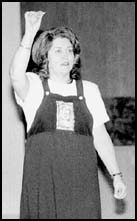 Attention deficit hyperactivity disorder (ADHD) is the most commonly diagnosed behavior disorder in children, according to Amy Ortega (at left), parent liaison person at Children's Mental Health, Minneapolis.
Attention deficit hyperactivity disorder (ADHD) is the most commonly diagnosed behavior disorder in children, according to Amy Ortega (at left), parent liaison person at Children's Mental Health, Minneapolis.Ortega met with parents and teachers to discuss ADHD at the Paynesville Area Elementary School Tuesday night for an awareness program.
Ortega is no stranger to ADHD as she has two sons who were diagnosed with the disorder when they were children. "My oldest son was diagnosed in the third grade with a mild learning disorder. Today, he has a Ph.D. in economics. My youngest son has a severe case and is in and out of hospitals," she told the audience.
"There is a lot of help for children once they are diagnosed. It is not as hard to get a child diagnosed as 20 years ago, but it is still a formidable task," she said.
ADHD is characterized by inattention, impulsivity, and hyperactivity. ADHD is not easily diagnosable and is often mistaken for or found occurring with other disorders.
There are three types of ADHD: inattentive, hyperactive/impulsive, and combined. Symptoms of inattention are: making careless mistakes; difficulty paying attention; not listening; failing to complete tasks; difficulty organizing things; losing things; being easily distracted; and avoiding tasks that require sustained effort.
Symptoms of hyperactivity/impulsivity include: fidgeting, inability to stay seated, excessive movement, difficulty playing quietly, excessively talkative, blurting out answers, forgetting, difficulty taking turns, and being constantly on the go.
Ortega explained that there is a strong gender difference in ADHD, nearly 90 percent of children diagnosed are boys. Differences in how boys and girls exhibit symptoms may play a role in the prevalence of ADHD in boys. Boys are more likely to be hyperactive than girls, and therefore attract a great deal of attention.
A girl with ADHD who daydreams at the back of a classroom may be unhappy and failing in school, but she does not attract the attention given to a boy who is constantly talking out of turn, jumping up from his desk, and pestering other children, Ortega added.
A diagnosis is made when a child has at least six symptoms from either list, with some symptoms having started before age seven. Symptoms displayed in at least two settings, such as home and school, must also exist.
Children who have six or more symptoms from both lists have the combined type of ADHD, the most common in school age boys. The inattentive type (sometimes called attention-deficit disorder) is found more often in girls.
"Parenting skills have nothing to do with a brain disorder. It is important to find out what is wrong and then a person can respond appropriately. There are a lot of unclear issues in dealing with ADHD. It is important parents know how their child acts at home, at school, and with their friends. A child can act differently from class to class, thus it is important to get a balance. Different teachers will perceive a child differently," she added. In about 10 to 60 percent of the cases, ADHD can persist into adulthood.
Medication and behavioral therapy have proven effective in treating children with ADHD. The four most commonly used medications are Ritalin, Dexedrine, Aderall, and Cylert. They increase activity in parts of the brain that are underactive in youth with ADHD.
Treatment strategies such as rewarding positive behavior changes and communicating clear expectations of the child are also effective.
For further information on ADHD contact Freida Jansen, 320-243-7233 or Christine Higgins, 320-243-7629, local parent coordinators for the ADHD-ADD of Paynesville.